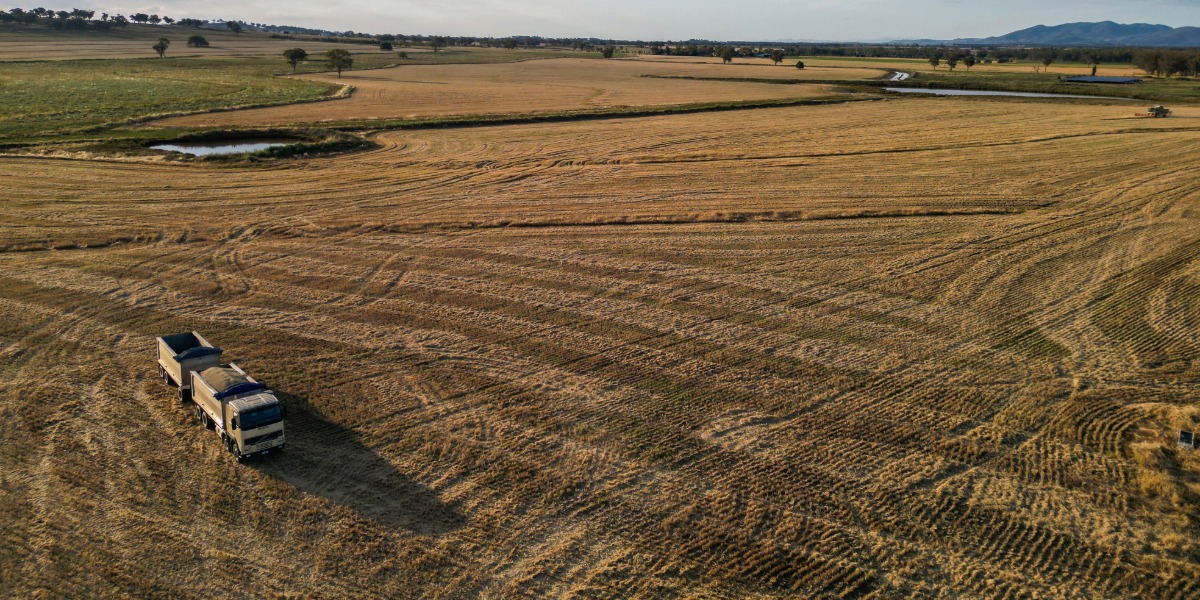House prices in Australia’s wheat belt have surged 85 per cent over the past decade while wheat prices rose just 26 per cent. The connection between these markets runs deeper than the headline numbers suggest, with extraordinary periods where they move in perfect synchronisation – driven by weather booms that lift all regions simultaneously – followed by dramatic decoupling phases when broader economic forces like interest rates override agricultural fundamentals.
This analysis examines 11 major wheat growing regions across Australia from 2015 to 2025, including NSW’s Central West, Riverina, and New England areas, Queensland’s Darling Downs and Central Queensland, Victoria’s North West and Warrnambool districts, South Australia’s Barossa-Yorke-Mid North and Outback regions, and Western Australia’s Wheat Belt and Outback South areas. Using annual wheat price data alongside regional median house prices, correlation coefficients were calculated to measure the statistical relationship between commodity movements and local property values across different time periods.
The grain belt connection
Over the past decade, wheat prices and house prices in growing regions have moved with a correlation coefficient of 0.66 – a statistically strong positive relationship. When wheat prices climbed 26 per cent from 2015 to 2025, average house prices across wheat regions surged 85 per cent. This connection makes economic sense: higher wheat prices mean better farm incomes, stronger rural economies, and increased demand for local housing.
The relationship peaked during 2019-2022, when every single wheat growing region showed perfect correlation with commodity prices. During this period, wheat prices jumped from $4.94 to $9.52 – a 93 per cent increase – while house prices across wheat regions rose from $255,000 to $325,000.
Weather drives the cycles
The correlation patterns align closely with Australia’s weather cycles, particularly La Niña and El Niño events. The 2019-2022 La Niña period brought exceptional rainfall across most wheat regions, creating bumper harvests and synchronised prosperity. During these years, all 12 wheat growing regions moved in perfect lockstep with wheat prices.
Since 2022, as weather patterns returned to normal variability, the correlations have shifted. Some regions now show negative correlations as wheat prices declined 33 per cent from their 2022 peak while house prices continued rising on interest rate cuts and broader housing shortage pressures.
Regional winners and losers
Not all wheat regions respond equally to commodity price movements. Victorian regions like Warrnambool and South West show the strongest long-term correlations, while Queensland’s Central Queensland region demonstrates more resilience during downturns.
NSW regions – including the Central West, Riverina, and New England areas – exhibit high sensitivity to wheat price swings but also show the most volatility. South Australian wheat regions display extreme sensitivity, swinging from very strong positive correlations during boom periods to equally strong negative correlations during adjustments.
Western Australian wheat regions fall in the middle, showing moderate but consistent sensitivity to commodity cycles.
The current disconnect
Since 2022, a disconnect has emerged. Wheat prices have fallen from their $9.52 peak to $6.43 today, yet house prices in wheat regions continue climbing. This reflects the broader housing market dynamics – interest rate cuts, supply shortages, and lifestyle migration – now outweighing agricultural factors.
However, history suggests this disconnect may not last. Previous cycles show that during stable wheat price periods, the correlation typically reasserts itself as other market forces moderate.
Local weather trumps national wheat prices
While national wheat prices provide the headline figure, local weather conditions determine whether individual regions actually benefit from commodity booms. Not all wheat regions move in sync with national prices because they may not be experiencing the same favourable growing conditions.
During the 2019-2021 La Niña period, exceptional rainfall benefited most regions simultaneously, explaining why all areas showed perfect correlation with wheat prices. However, as weather patterns returned to normal variability after 2022, regional differences emerged. Some areas continued to experience good growing conditions while others faced drought, flooding, or other challenges that disrupted their connection to national commodity trends.
Victorian regions, which include the reliable Wimmera and Mallee districts, tend to show more consistent correlations partly due to their relatively stable rainfall patterns and established irrigation infrastructure. In contrast, the more weather-dependent rain-fed regions of NSW and South Australia exhibit stronger correlations during boom periods but also greater volatility when conditions turn.
Queensland’s wheat regions operate on different seasonal cycles and face different weather systems altogether, which helps explain their more moderate correlation patterns. Western Australian regions fall somewhere in between, with their Mediterranean climate providing reasonable reliability but still subject to significant year-to-year variation.
The wheat belt property story ultimately reflects local agricultural reality rather than just national commodity headlines. Regional growing conditions, seasonal timing, and weather resilience all influence whether rising wheat prices translate into local economic prosperity and housing demand.
Got something on your mind? Go on then, engage. Submit your opinion piece, letter to the editor, or Quick Word now.

